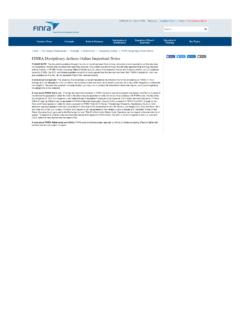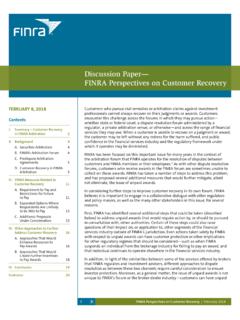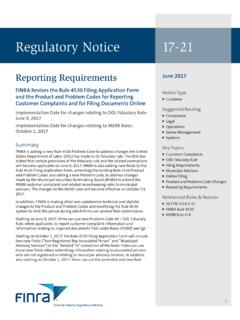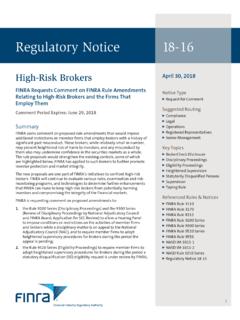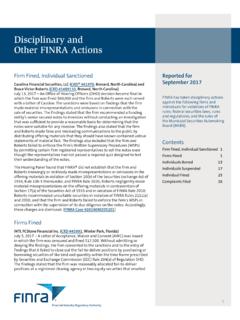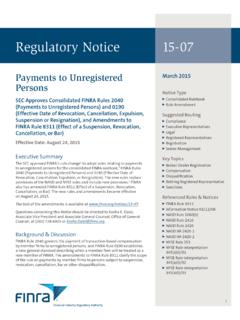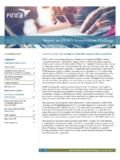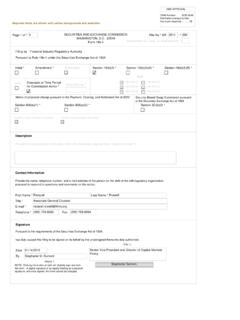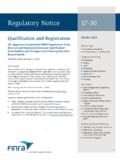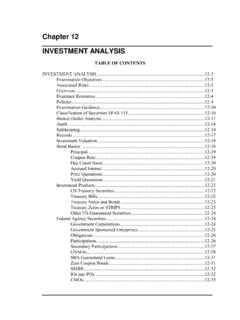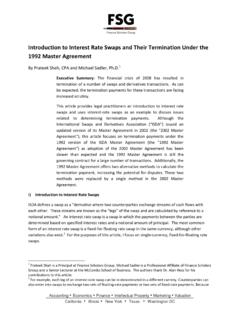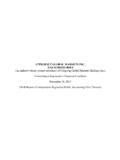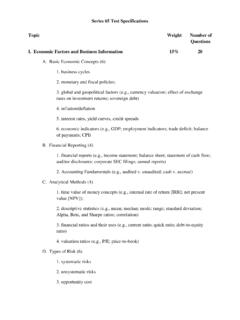Transcription of Content Outline for the S101 Regulatory Element Program
1 Content Outline for the S101 Regulatory Element Program Introduction The Content for the S101 is organized into four modules. The Content of each of these modules is listed following this overview. Unless otherwise specified, topics are covered at basic levels of knowledge and understanding. The securities Industry Continuing Education Program (CE Program ), which is required by the rules of several self- Regulatory organizations (SROs), is a two-part Program composed of a Regulatory Element and a Firm Element . The Regulatory Element is developed by industry committees representing a diverse range of broker-dealers (BDs), in conjunction with the securities Industry/ Regulatory Council on Continuing Education, industry Regulatory agencies and SROs.
2 The Firm Element must be developed and delivered by each firm on an annual basis. The CE Program is intended to keep registered securities industry personnel current regarding rules and other issues important to performing their jobs appropriately. The Regulatory Element The Regulatory Element requires all registered persons to participate in a prescribed computer- based training session within 120 calendar days of their second registration anniversary date and every three years thereafter. Failure to complete the Regulatory Element within 120 days of the prescribed anniversary date will result in a person's registration becoming inactive. The Regulatory Element is designed to cover significant subject matter that is broadly applicable to all registered persons.
3 The Regulatory Element focuses on compliance, Regulatory , ethical and sales-practice standards. Its Content is derived from rules and regulations, as well as standards and practices widely accepted within the industry. Although the specific requirements of certain rules may differ slightly among the various SROs, the Program is based on standards and principles applicable to all. In certain instances, particular SRO requirements may be more restrictive than those represented in the Regulatory Element . Additionally, BDs may have policies and procedures that are more restrictive than industry regulations regarding the types of activities in which their registered employees may engage, the investment products they may represent, and/or specific approvals required for certain functions.
4 Registered persons and their supervisors are responsible for ensuring that their activities are within the scope permitted by their employing BDs and conducted in accordance with the rule requirements of all of the SROs and jurisdictions regulating them. Please note that a sample case and an orientation are provided as resources for those who would like to familiarize themselves with the Regulatory Element Program format and features. Those required to take the Regulatory Element are encouraged to review these resources prior to taking their session. Candidates currently eligible to take the Program can do so online at 1. Presentation of the Training In each module, participants are led through a case that provides a story depicting situations that may be faced by registered persons in the course of their business.
5 Each case contains significant educational Content , including optional Resources and Glossary Rollovers. Participants must review the story Content of each case but may choose whether to utilize the optional materials. Participants are encouraged to utilize all of the educational Content provided in the S101 as it is designed to aid understanding and enhance the educational experience for the participant. The format of the cases in the S101 Program is text-based with some media treatments that provide important information, context and education related to the story. The S101 is divided into four modules: Module A: Responsibilities to Customers Module B: Operational Responsibilities Module C: Regulatory Responsibilities Module D: Personalized Cases In Module D, participants select from among seven categories to focus their session on the one function that is most relevant to their daily work.
6 Series 6 Retail Sales Series 7 Retail Sales Institutional Sales Trading Operations Investment Banking Research Assessment, Proficiency and Timing As part of each case, participants are asked a series of questions. These questions are designed to assess the participants' understanding of the materials presented. Participants must demonstrate their understanding of the subject matter by choosing the most appropriate response(s) to questions. Participants must demonstrate proficiency in each of the four modules of the S101. Participants that do not demonstrate proficiency with the subject matter will cycle through cases within the same module until proficiency is achieved. Failure to complete the Regulatory Element within 120 days of the prescribed anniversary date will result in a person's registration becoming inactive.
7 2. S101 Content Outline Module A: Responsibilities to Customers: Communications with the Public, Suitability, and Basic Product Knowledge This module focuses on four major areas with respect to responsibilities to customers. Types of Communications This section includes definitions, permitted uses, restrictions, approval, and retention requirements for written, electronic and oral communications. Examples: email, instant messaging, social media, telemarketing, advertising and seminars Content Standards, Review and Approval Requirements This section focuses on industry requirements designed to ensure that all communications are fair and balanced and do not contain misleading, exaggerated or unwarranted statements or omit material facts.
8 Examples: professional designations, internal-use-only documents, research, copyrighted materials, testimonials, retail versus institutional communications, predictions, projections, performance guarantees, blanket recommendations, and prohibitions and restrictions related to distribution Suitability This section addresses suitability requirements including obtaining, monitoring and periodically re-confirming client information in order to determine the suitability of investments prior to making any recommendations. Examples: Client profile information, including age, income, net worth, investment objectives, experience, risk tolerance, tax status, time horizon, liquidity needs and other securities holdings Product Knowledge/Investment Vehicles and Implications Related to Risk This section focuses on characteristics, risks and disclosure requirements of products/investment vehicles and strategies.
9 Examples of Products: equities, fixed-income securities , packaged products and alternative investments Examples of Risk: market, interest rate, credit, sector, etc. Examples of Investment Vehicles and Strategies: retirement plans, asset allocation, rebalancing and dollar-cost averaging Module B: Operational Responsibilities: Customer Accounts, Trade and Settlement 3. This module focuses on the following six substantive areas with respect to operational responsibilities. Account Opening and Maintenance This section includes procedures and information required for opening and maintaining client accounts, including approvals, recordkeeping and delivery of account documentation.
10 Examples: customer identification Program (CIP), ACATs transfers, safeguarding of client information (Regulation S-P), delivery of disclosures and required account documentation (margin, options, prospectus, privacy policy, SIPC/FDIC disclosures). Client Account Registrations This section focuses on the different characteristics of client accounts. Examples: individual, joint, estate, custodial, trust, retirement, education funding and corporate accounts Trade Authorization and Approval This section identifies requirements for order entry, confirmation, trading authorization, errors and erroneous reports. Examples: discretionary trading authority; time and price discretion; types of powers of attorney (POA); obligations and limits of fiduciaries; trading disclosure (penny stocks); types of orders.

